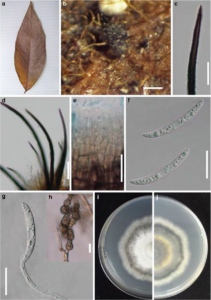Colletotrichum aciculare Jayaward., Tangthir. & K.D. Hyde, in Ariyawansa et al., Fungal Diversity: 10.1007/s13225-015-0346-5, [130] (2015)
Index Fungorum number: IF551298; Facesoffungi number: FoF: 00850
Etymology: Based on the acicular conidia.
Holotype: MFLU 13-0280
Saprobic on leaves. Sexual morph: Undetermined. Asexual morph: Conidiomata 200–450 μm (x̄ = 370 μm, n=10) diam., solitary, an acervulus, black, globose, conidiophores and setae formed on a cushion of pale brown angular cells. Setae abundant, 109–215 μm long, dark brown to medium brown, paler towards the apex, smooth-walled to verruculose, straight or slightly curved, 1–4-septate, base cylindrical, conical with slightly inflated, 3–5 μmdiam., apex slightly acute to roundish. Conidiophores septate, to 32 μm long, hyaline to pale brown, smooth–walled. Conidiogenous cells 17–26×3– 4 μm (x = 21×3 μm, n=20), hyaline, smooth–walled, cylindrical to elongated ampulliform, opening 1–4 μm diam., collarette sometimes visible, periclinal thickening visible. Conidia 37–43×2–5 μm (x = 40×4 μm, n=40), hyaline, acicular, aseptate, curved, both sides gradually tapering towards the round to slightly acute apex and truncate
base, guttulate, smooth-walled or verruculose, L/W ratio= 8.9. Appressoria 8–12×2–4 μm (x = 12×3 μm, n= 10), solitary to aggregated, globose to subglobose, pale brown, smooth-walled.
Cultural characteristics: Colonies on PDA reaching 60 mm in 7 days at 28 °C, margin feathery, white aerial mycelium becoming pale yellow towards the edge from above, reverse peach coloured (4), becoming black with age.
Material examined – THAILAND, Chiang Rai, on a dead leaf, host unknown, 15 July 2012, Yee Than NTCL91-2 (MFLU 13-0280, holotype); ex-type living cultures, MFLUCC 12–0425, KUMCC, CFTCC.
Notes – Colletotrichum aciculare clusters in the truncatum species complex (Fig. 85), forming a separate branch with 80 % bootstrap support and 0.95 Bayesian posterior probability. This species differs from C. curcumae (Syd. & P. Syd.) E.J. Butler & Bisby by having dark brown to medium brown setae, becoming pale towards the apex, while setae of C. curcumae are dark brown up to the apex (Damm et al. 2009). The L/W ratio of C. aciculare conidia (8.9) is larger than the L/Wratio of C. curcumae conidia (4.2) (Damm et al. 2009).

Fig. 1 Colletotrichum fusiforme (holotype) a Herbarium specimen b Black acervuli c Acute apex of the setae d Setae with conidiophores e Conidiophores f Hyaline conidia g Germinating conidiumh Appressoria i Upper view of the colony j Lower view of the colony. Scale bars: b= 100 μm, c, d=20 μm, e–g=15 μm, h=10 μm
